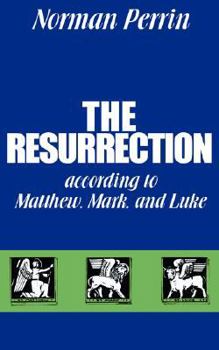The Resurrection According to Matthew, Mark and Luke
Select Format
Select Condition 
Book Overview
The New Testament resurrection narratives must be understood in both their similarities and their differences. Norman Perrin was a leading interpreter of the Gospels. In this book he relates each... This description may be from another edition of this product.
Format:Paperback
Language:English
ISBN:0800612485
ISBN13:9780800612481
Release Date:March 1995
Publisher:Augsburg Fortress Publishing
Length:96 Pages
Weight:0.25 lbs.
Dimensions:0.4" x 5.0" x 7.5"
Customer Reviews
3 ratings
A Fine Little Resurrection Intro
Published by Thriftbooks.com User , 16 years ago
This is a little jewel of a book by Norman Perrin. At only 85 pages (1977 edition), it's a short and clear introduction to the reputed resurrection of Jesus. It is also more satisfying and convincing than N. T. Wright's massive, convoluted, 2003 work on the same subject. Perrin's book should appeal both to liberal Christians and to non-Christians including secular humanists (like me). Hopefully some conservative Christians can appreciate it too. Published in 1977, it was his last work. He focuses on the "synoptic" (similar) gospels of Mark, Matthew, and Luke, but also offers a few very important insights about the understanding of the reputed resurrection and/or ascension of Jesus in Paul and in Acts. Only the unusual gospel of John is left completely out of Perrin's consideration. That is a shortcoming, but a small one. Perrin's special concern here is "redaction criticism," a fancy term for the study of the ways that each successive gospel writer (evangelist) changed the text of the previous gospel writer. Take, for example, Mark and Matthew. The gospel of Mark, though it follows Matthew in the New Testament, was actually the first gospel written, and it ends rather bleakly at 16:8 with the women followers of Jesus fleeing his empty tomb in fear, with no appearance of a resurrected Jesus (Mark 16:9-20 is a much later addition, as all scholars agree). Contrary to the claim of a previous reader-reviewer here, Perrin actually "concedes" only one very minor (grammatical) argument that Mark originally had a longer ending. He also relates an abundance of persuasive evidence, pp. 16-33 (1977 edition), that Mark originally ended at 16:8, with no other "lost" ending to it, a conclusion shared by a majority of scholars in the field (though some conservative Christian scholars desperately want to believe in a lost ending that contained a resurrection appearance story). Perrin then notes that the author of Matthew borrowed the empty tomb scene from Mark but altered it in his own gospel to include a brief peek-a-boo appearance by Jesus (28:9-10), thus offering his readers a softer and happier ending than Mark's scene did. Yet, the author of Matthew did not feel free to make too many changes to Mark's scene. So Matthew retains the saying that a risen Jesus will see his disciples in Galilee. Unfortunately, in Matthew this saying is illogically placed in the mouth of the risen Jesus himself appearing right there at Jerusalem. Perrin, with his generous view of myths, does not call the scene silly, but one easily could. Perrin writes that the earliest Christian understanding of the resurrection of Jesus was essentially that of an ascension. Jesus was "raised from the dead by God," yes, but only "to sit at the right hand of God." The epistles reflect this belief abundantly. However, when the early Christian expectation of a Second Coming of Jesus gradually faded over the decades, because, of course, he did not come, that intense apocalyptic
A must-read book: a gem.
Published by Thriftbooks.com User , 18 years ago
Perrin's book lays out, in sparse, analytical prose, a concise understanding of the development of the understanding of the resurrection as displayed in the Gospels of Mark, Matthew, and Luke. He treats the material respectfully, and makes important contributions to understanding the meaning of the resurrection in academic as well as personal terms. He describes, in detail, the evidence from Paul, and uses Paul's understanding of the resurrection to illuminate the later depictions in the Gospels. It is a book of knowledge, and a book of faith.
Good Redaction Criticism
Published by Thriftbooks.com User , 23 years ago
Norman Perrin is a well-respected New Testament critic for good reason. Perrin provides first-rate redaction criticism of the resurrection narratives in the synoptic gospels that sheds light on the purposes of the authors and the meaning of the myths. Perrin stresses that the importance of the resurrection stories does not lie in their literal, historical accuracy. Apart from Perrin's idea that Mark refers to the parousia instead of an appearance in 16:7, I found nothing in it to be disagreeable. Although conservative Christians will not appreciate Perrin's insight, liberal Christians should find that this book enriches an understanding of their faith. Secular students of the New Testament, such as myself, will find Perrin to be a good source for sound observations on the texts.






